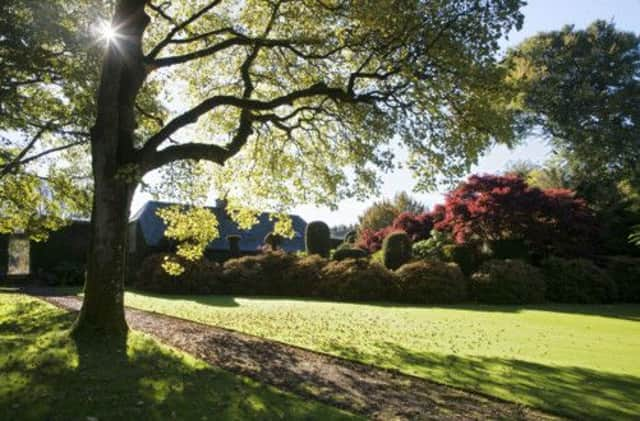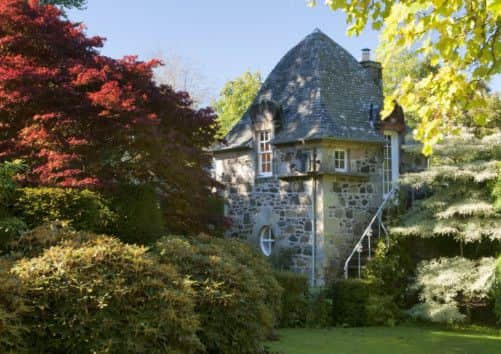Sir Robert Lorimer’s garden restored to former glory


Thirty five years ago, when Briony and Fred Multon first moved to Briglands, their Lorimer-designed house in Kinross-shire, Briony would dread the advent of spring. “I would go into a decline knowing there would be months of weeding and grass cutting ahead,” she recalls. With a young family she had little time to garden, but Fred, an architect, took an interest in the landscape, building paths, walls and establishing viewpoints. He also planted the beech and yew hedges creating the structure that would later form a spectacular backdrop to fiery autumn planting.
Briglands, a former Georgian farmhouse transformed by the architect Sir Robert Lorimer in 1898, sits in a raised position on the side of a hill. Lorimer also laid out the gardens, including a horizontal lime avenue flanked by a path that runs the length of the garden, dividing it in two: a formal space of lawns and terraces close to the house with a woodland garden to the rear.
Advertisement
Hide AdAdvertisement
Hide AdLorimer also planted some of the hedges and rhododendrons that remain a fundamental part of the planting scheme. “After Lorimer, very little was planted,” Briony explains. “And after the Second World War, the 13-acre garden, like so many others at that time, fell into decline.”


Once her youngest child left home Briony decided they “either had to move or I got into gardening”. Drawing on Fred’s willingness to invest time and money, she set to work. “It was a joint effort,” she says. “Fred is like a very intelligent labourer. Very happy to dig a hole, but then he started to question my decisions,” which gave rise to lively debates. “I sometimes wonder what Fred is doing when he makes suggestions,” she says. “But he is always right.”
As an example, she cites his encouragement to plant in large numbers. While she hesitates between one or three rhododendrons – some of her favourite plants, loved both for their different foliage, geographical and historical association and the pure fun of growing them, some from seed – Fred will say “plant ten”.
Autumn became a favourite season. “It’s a time when the mad rush is over, and you can think about the garden and plan,” Briony says.
Learning about autumn plants was key and visits to Bodnant, the National Trust garden in Wales, Arabella Lenox Boyd’s Gresgarth Hall in Lanarkshire, and the gardens at Glendoick in Perthshire provided inspiration. She also read a lot, learning about scarlet leaved Euonymus E. alatus ‘Compactus’, wine red Persian ironwood, Parottia persica and varieties of acers. “I planted everything all over the place,” she says, “It’s all looking particularly good this year.”


That the on-going project has worked is evident from the moment you turn onto the drive that winds up the hill. To your right is a large fairly bare area resulting from a tree being blown down last year. “I mourned its loss for two months,” Briony says, “then decided to create a winter garden.” Here, in contrast to the surrounding mature trees, are a group of five young Betula ‘Inverleith’, their foliage golden, and a pair of feathery Hamamelis that will take centre stage in winter. The addition of red stemmed cornus will complete this fiery scheme.
Continuing to the left you walk through the old orchard where fruit trees (at a height of 500ft here, they don’t do well) are being replaced with prunus for its foliage and blossom, and sorbus for its wine red autumn foliage, and pink and white berries. On the left, a low beech hedge encloses a rock garden.
The path leads in a circular movement back round through the woodland where shrubs such as rhododendrons and Pieris combine with evergreens in a dense tapestry of foliage and texture. The scheme is brightened by purple splashes of autumn crocus, Colchicum agrippinum and Cercidiphyllum japonicum with its bronze foliage smelling of burnt sugar.
Advertisement
Hide AdAdvertisement
Hide AdFrom here it slices though the top of the garden, under the old arch, soon to be replaced with Fred’s Folly, a steeple-shaped structure, which, once finished, will allow views over the garden and into the countryside beyond. Wander past the croquet lawn and you reach the circular rose garden, enclosed to form a secret, hidden space. Here, in response to the high rainfall, Briony is slowly replacing roses with peonies and “single annuals, such as cosmos, which allow increasingly rare bees maximum access to nectar.”
As you enter the walled garden, you are struck by the red and yellow dahlias that, due to their sheltered position, have defied the cold nights to continue producing spectacular flowers. Here a gravel path runs through a bed packed with Sedum ‘Autumn Joy’, Crocosmia, white wands of Actea simplex and Japanese anemone.
A few steps further west a dramatic castellated yew hedge is embellished with cones and spirals. Running the full length of the vegetable garden and continuing lower down past a quirky cluster of stone outhouse and potting sheds in the formal garden, this iconic hedge is reminiscent of the yew hedges designed by Lorimer at Earlshall Castle in Leuchars, Fife.
The vegetable garden, divided into rectangles furnished with raised beds, is the preserve of head gardener Jane Baillie, whose skills and practical knowledge have been invaluable during the past seven years.
Walking back along the path past the southern elevation of the house you look up over the lawn and back towards the vibrant tapestry of foliage, and marvel at the skill and commitment that has bought this impressive garden to life. “I think this is my favourite season,” Briony says. “But then I love the spring too when the rhododendrons are in flower.” It is clearly hard to choose: before we started our tour Briony also insisted winter was her favourite season.
Briglands, Rumbling Bridge KY13 0PS is open under Scotland’s Gardens on Sunday 18 May 2014 and also by appointment for groups (01577 840 205, [email protected]; scotlandsgardens.org)